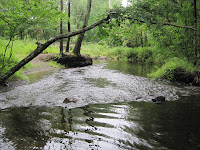Guest Author: Diane Biello
My name is Diane Biello and I serve on the Board of
Directors of my local land trust. I have been interested in water conservation
and aquifer protection for over 20 years and got involved in land conservancy through a family inheritance.
When my husband’s uncle died without a will, he left 129
acres of land in Stowe, VT, in what are called “undivided shares.” That means the land was owned in common by
six family members who shared in it as a whole. Doing anything with the land meant
getting the agreement of all six people.
Getting six headstrong and sometimes-cantankerous Vermont Yankees to
agree on anything can be a difficult task and the land remained undeveloped
hillside for many years.
We wanted to protect the property from any future development
and started by consolidating ownership.
We bought out some of the people, while his mother and an uncle donated two
quarter shares. It took us 10 years to consolidate
the property with a goal of keeping the land in its wild
state. We put a Conservation Restriction
on it in 2000, including an “envelope” for a cabin.
 |
| An esker on 63 acres over an aquifer: owned by the Rehoboth Land Trust |
That sounds simple but it meant learning first about the
different ways in which property can be protected, both on Federal and state
levels. The more I learned, the more
interested I became and the more involved I got. When I talk to people, I find many folks who want
to learn more about how they can help and what they can do to protect open land,
so I put together this overview explaining land
trusts and conservation restrictions.
A land trust is simply a 501
3c charitable trust that protects land from being developed in perpetuity. That means it can be farmed, used as pasture, harvested
as a woodlot or simply allowed to lie fallow.
Usage depends on what you want and you can personalize the trust to fit
your needs.
There
are many land trusts around the country and they vary in size from small local
ones such as our Rehoboth Land
Trust to larger ones such as The
Trustees of Reservations. Both of
these organizations work only in the state of Massachusetts and the latter is
the oldest land trust in the country.
The Trustees own and care for more than 100 special places—over 25,000
acres—across the state. Other land
trusts are global in nature, such as The
Nature Conservancy, which works in all 50 states and 30 countries.
We
used The Nature Conservancy for our restriction. While the plot wasn’t large by their
standards, they are typically interested in environmentally significant pieces
of land. The Conservancy wanted to help
us protect our acreage because it helped create a “green corridor,”
which connects areas of wildlife habitat that are separated or interrupted by
human activities. Our land is part of a corridor
for large mammals that connects the two tallest peaks in Vermont: Camel’s Hump
and Mount Mansfield.
 |
| Tributary of the Palmer River: land donated to the Rehoboth Land Trust |
How do land trusts protect parcels of land? They do it in
two ways: either by ownership of the land or by putting a conservation
restriction on it.
Donating land is the simplest and most
straight forward method of permanent land conservation. It transfers ownership
and management responsibilities to the land trust of your choice. You can
donate an entire parcel or portions of a parcel. You may also reserve a life estate.
Sometimes a land trust protects an important parcel by
purchasing the land outright. A
landowner may also choose to make a “bargain sale,” which means selling it to
the trust at below current value.
A recent, and more common method of protecting property from
development, is through a Conservation
Restriction (CR). A CR is a legal agreement, in writing, that permanently
removes the owner’s right to develop land in order to protect the ecological,
scenic and/or agricultural significance of the property. A CR maintains your private property rights
and, possibly, gives you significant tax benefits. The land owner promises that
certain activities will not occur on the property. By accepting the CR, the
land trust or government agency agrees to monitor and enforce the terms of the
restriction.
 |
| Farmland owned by the Rehoboth Land Trust |
Here’s an example of a Conservation Restriction that has
occurred with some frequency here in Massachusetts. When a farmer dies, the cost of the land in
urban areas can be so high that the heirs cannot afford to pay the inheritance
tax. They are forced to sell the land,
which is then developed. If a farmer puts a CR on his property while he is
still living, developers cannot do anything with it. This lowers the value of the land—and the size
of the inheritance tax—dramatically.
Some farmers choose to put an Agricultural
Preservation Restriction (APR) on their property, which requires that the
land remain in agricultural use. Our state encourages this, especially for
farms with prime soils, and will pay some farms that qualify.
There are a variety of tax benefits available for grantors of
conservation easements.
Easements can be written in a variety of ways. A family who
wishes to put a CR on their property but has a child to whom they would like to
leave a house lot can do so by delineating an area around the piece of land
that will be exempt from the easement. This is generally referred to as an envelope.
Easements can be tailored to the individual land owner’s needs and wishes.
This is a broad overview of land trusts and what they hope
to accomplish via land protection. A trust can do you and the environment a lot
of good. For more specifics see information
on the Land Trust Alliance web
site or contact your local land trust.
No comments:
Post a Comment